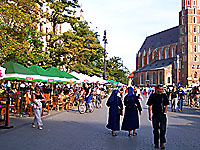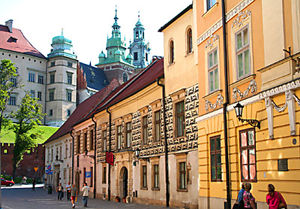
The
Streets of Historic Krakow.
Strolling the streets of Krakow’s vast
Old Town historic
district is a most rewarding experience. The original
mid-13th-century grid within the ring of mighty city walls has
been filled with architectural beauties by the ensuing
epochs – imposing churches, grand aristocratic palaces and stately
houses of burghers; Gothic, Renaissance, Baroque, Rococo, and
Classicist, plus a few of the 20th century. Each Krakow street
has its unique character and a climate of its own; each is rich
in history and many different stories. And every street lives
its own life manifest in its cafes,
stores, galleries, assorted culture venues and public institutions.
Notable streets of Krakow.
Florianska Street forms the first half of the ceremonial
Royal Road. It leads from the main city gate of the same
name to the giant Grand Square and is closest thing to the
principal street of Krakow. At 45 Florianska St. the
Jama Michalika cafe (est. 1895) boasts period Art Nouveau
decor. At no. 41 there is The House of Jan Matejko, the great
19th-century painter’s residence turned into a museum. At no. 25
the Pharmacy Museum, possibly Europe’s such
biggest. The street ends at the foot of the 14th-century Gothic basilica of the Virgin Mary’s, the
city’s chief and biggest church. Every full hour the ancient Krakow Signal is trumpeted to the world’s
four sides from its taller, crowned tower. The basilica
overlooks the Grand Square, Europe’s largest medieval city
square. Over the last 800 years the Florianska street witnessed
countless glorious processions: coronation, funeral, royal
wedding, etc. Nowadays the former thoroughfare has been taken
over by pedestrians and Florianska Street remains Krakow’s busiest shopping area.
Grodzka Street from the 9th century on used to form an axis
of Poland’s capital prior to the location of medieval city of
Krakow around the Grand Square in 1257. Leading to
Wawel Hill’s
royal castle and cathedral, the street has witnessed all
kinds of processions passing by in step with
history. One block down the Grodzka street from Krakow’s
central square there is an open space flanked by two grand
13th-century temples. Left, the Gothic
basilica of Holy Trinity
dwarfs the adjacent Dominican monastery. Right, the Romanesque basilica of St. Francis’ adjoins a
Franciscan monastery. Both monasteries boast the 14th-century
great cloisters full of art. The Franciscan one neighbors the
1560 Renaissance Wielopolskich Palace, Krakow’s
city hall since 1865. Further down the street a charming
plaza spreads before an ornate white facade of the imposing
Jesuit Baroque church of St. St. Peter
and Paul’s of 1619 next to the grand Romanesque church of
St. Andrew’s of circa 1090.

Kanonicza Street ends just at the foot of the
hilltop Wawel Royal Castle and used to constitute
the last, most glorious and scenic part of the
Royal Road, Krakow’s ceremonial route. Lined with stately,
mostly Renaissance houses, it is arguably one of Europe’s finest
streets. In its half a charming plaza unveils the white facade
of the imposing Baroque church of St. St.
Peter and Paul’s of 1619 next to the grand Romanesque
church of St. Andrew’s that dates from the late 11th century.
Golebia Street (i.e. Pigeon St.) has been the axis of the
Krakow university quarter for nearly six centuries. Till the
14th century a small Jewish quarter bordered here on the borough
where the Polish potters dwelled and toiled. When the Grand
College, Collegium Maius, was
established nearby in 1400, various academic institutions
mushroomed soon along the street. The Collegium Minus at
11 Golebia street, built for the younger philosophy faculty in
1449, now shelters the university’s Institute of Archeology. The
huge Neo-Gothic Collegium Novum of red brick at 24
Golebia street, on its western end, was built in 1887, and is
home to the Krakow university’s headquarters. Nowadays students
no longer live here and most of them study on modern premises
outside the Old
Town historical district. Yet the old colleges still form
the hub of the Jagiellonian University. So, there is no shortage
of patrons for cafes, specialty shops, boutiques and the like,
which line the Golebia Street.
Jagiellonska Street runs parallel to the western side of
Krakow’s central Grand Square and
connects Poland’s two most prominent cultural institutions. At
its one end there is the 630-year-old
Jagiellonian University with the
Collegium Maius, a marvellous 15th-century college
turned into a university museum. Stary
Theater, Polish oldest and a home to the country’s best
company of players, stands at the other end.
Sw. Anny Street till the 14th century formed the oldest
Jewish quarter of historic Krakow. In 1400 the Jagiellonian University moved in. Its
15th-century splendid Gothic Collegium Maius welcomes visitors in
the middle of the Sw. Anny (i.e. St. Anna’s) street. The former
college attended by Copernicus now houses the university museum
and its world-class exhibits. Two younger colleges stand next to
it: the 17th-century Baroque one and the 19th-century classicist
edifice where two Krakow’s physicists achieved the first ever,
breakthrough condensation of the oxygen and nitrogen from the
air. The opposite university church of St. Anna’s of the late 17th
century is a wonderful example of the majestic Baroque
architecture at its best.
Szewska Street (i.e. Shoemakers’ St.) has been known at
least since 1309 under its current name after the trade most
common here in the Middle Ages. It was important for medieval
Krakow’s economy as the city shone in the production of
excellent footwear. Nowadays the Szewska street still counts
among the historic Old Town’s
busiest, though the likes of Casio, Sony and Levi’s replaced
local wares while shoemakers gave way to jewelers,
nightclubs
and cafes.
Karmelicka Street, once an old road westward from Krakow’s
medieval Szewska Gate, was changed at the turn of the 20th
century into a fashionable boulevard. Extramural cottages and
gardens gave way to solid buildings in eclectic style.
Nonetheless, the Carmelite church
with adjacent monastery, dating back to 1087, has remained the
Karmelicka street’s prime landmark. The 17th-century Baroque
temple is mostly known as a shrine of the Blessed Virgin of
Piasek, a 15th-century miraculous and
sacred wall painting.
Mikolajska Street (i.e. St. Nicholas’ St.) constituted once
the first part of the important trade route to Kiev in Ukraine.
In the Middle Ages it led from Krakow’s central Grand Square to the city’s eastern St.
Nicholas’ Gate whose Gothic stone arch can be still seen from
the Planty gardens in the outside wall of a
baroque convent. The nunnery and its church of the Holy Virgin
of Snow were built on the site of the gate fort in the 17th
century.
Pijarska Street forms the northernmost border of Krakow’s
Old Town historic quarter. Unassuming as it seems the
picturesque byway links some of the city’s best attractions. It
lines the preserved section of the city walls of circa 1300, complete with the
14th-century main gate, the giant
Barbican of 1499 in its front, and the 16th-century
municipal Arsenal. The last building, together with the adjacent
18th-century former monastery and the Neo-Gothic Czartoryskich
Palace across the Pijarska St, houses the
Czartoryskich Museum, by far Poland’s best collection of the
Old Masters, whose crown jewel is Leonardo da
Vinci’s fabled ‘Lady with an ermine’.
The museum adjoins the 18th-century church of the Transfiguration whose
fancy baroque facade shields grateful interior, enlivened with
illusionist depiction of heaven on the ceiling frescos. Next the
Pijarska street borders on the Planty string of public gardens. The
street ends at the wall of the 17th-century picturesque
monastery and the church of St. Casimir’s (available on the
turn to the left). The part of the Pijarska street adjacent to
the old city walls serves as an open-air gallery of sidewalk
artists, who adorn the ancient fortifications with their
canvases for sale.
Szpitalna Street (i.e. Hospital St.) is marked at its
northern end by the splendid edifice of the Juliusz Slowacki Theater whose
architecture, compared to the famous Paris Opera, was once
considered a model and copied throughout the Eastern Europe. In
1893 it was erected in the place of demolished buildings of the
14th-century hospital which gave the street its name. Further
down the street there was also Scholar’s Hospital whose
beautiful 15th-century building has survived at 21 Szpitalna. The baroque
church of St. Thomas’ and the adjoining convent date back to
1618. The opposite building at 15 Szpitalna St. was constructed
for a bank in 1883 and represents northern Neo-Renaissance in
its best.
Sw. Jana Street (i.e. St. John's) leads from the
city’s central
Grand Square to the Czartoryskich Museum, Poland’s best
collection of the Old Masters including Leonardo da Vinci’s fabulous masterpiece, ‘Lady
with an Ermine’. Yet, instead of rushing, you had better
enjoy the stroll down one of the finest streets of Krakow’s
historic Old Town quarter.
Sw. Jana street was named after the 12th-century church in its middle which owes its
present charming Baroque to the renewal in the 18th century. The
street is lined with palatial residences of noblemen and stately
houses of rich burghers. Their Gothic, Renaissance, Baroque and
neoclassical portals delight those with an eye for architectural
detail. And few stay unmoved by a vista of the 18th-century
Piarist church of the Transfiguration at the end
of the street. Behind the church’s fancy Baroque facade one
finds grateful interior with illusionist depiction of heaven on
the ceiling frescos. The Sw. Jana street’s chic boutiques,
art galleries, cafes, and numerous
nightspots
is frequented by bohemian types.
Stolarska Street just a block away east of Krakow’s Grand Square was named after carpenters
whose workshops used to line it from time immemorial till the
1960s. Nowadays the “Joiners’ Lane” has been taken over by
foreign diplomats. Three consulates operate here side by side:
the American, the French and the German ones. Of those the
American Consulate General at 9 Stolarska street is by far the
most popular, notably among the visa-seekers from the southern
provinces of Poland. The street runs along the vast compound of the
Dominican monastery that dates back to the 1222. It ends at the
foot of the friars’ 13th-century basilica of the Holy Trinity rich in
masterpieces of sacral art it accumulated over the ages. The
grand stairs at the left wall of the nave lead up to a Baroque
mausoleum of St. Jacek (Hyacinthus) in the former cell of the
13th-century Polish saintly monk.
Slawkowska Street Believers adore the medieval crucifix in
the church of St. Mark’s at
Slawkowska Street for its miraculous powers; nonbelievers simply
admire the masterly sculpture. The 13th-century church was
rebuilt in the 15th century when it acquired the present
picturesque Gothic outer form. Its interior dates back to the
late Renaissance. St. Mark’s church is also a shrine of the cult
of Blessed Michal Giedroyc, a saintly visionary who lived here
in the 15th century. Just across the street one finds
the seat of the Academy of Sciences (Akademia Umiejetnosci), a venerable 180-year-old
scholarly institution. Slawkowska street, originally a part of
the commercially important route to Silesia and further on to
the Western Europe, became one of Krakow’s principal streets as
early as the 13th century. It remains one of the busiest in the
city’s historical center.
Sw. Tomasza Street (i.e. St. Thomas’) has run parallel to
the northern edge of Krakow’s central Grand
Square at least since the 14th century. Yet the street
acquired its current name barely a century ago, which is hardly
typical for the
Old Town quarter with its ages-old street names. It is
divided roughly in half by the church of
St. John’s which dates back to the 12th century and was
given a Baroque facelift in the 17th century. The street creates
a most charming corner where it goes round the temple. The 1618
church of St. Thomas’ after which the street was named stands
two blocks farther at the corner with the Szpitalna street. The
Sw. Tomasza Street is lined by numerous charming
cafes, some counted among the city’s trendiest. The
19th-century hotel building at the corner with the Sw. Jana
street has been turned into an entertainment complex with
a cinema,
Krakow's biggest jazz club, and more.
Krakow Old Town
Historical District
Poland's prime tourist attraction and a must-see in
Central Europe boasts numerous world-class monuments, charming
vistas, delightful atmosphere, and the best restaurants.
Kanonicza Street
The most beautiful of Europe's ancient streets,arguably.
Planty Garden Ring
Park of 30 varied gardens among old trees round
Krakow's Old Town historical district
|
Krakow Squares
Krakow on Foot
The best way to enjoy old Krakow is afoot.Stroll Up the Royal Road
Stroll Round the
Grand Square
Stroll through
Krakow's Kazimierz District
In the footsteps
of Pope John Paul II
Street art in
Krakow
Map of Krakow
Krakow's Old Town
map
Getting around Krakow
Krakow's best restaurants
Lodgings guide to Krakow hotels
Enjoying Krakow on budget
|




